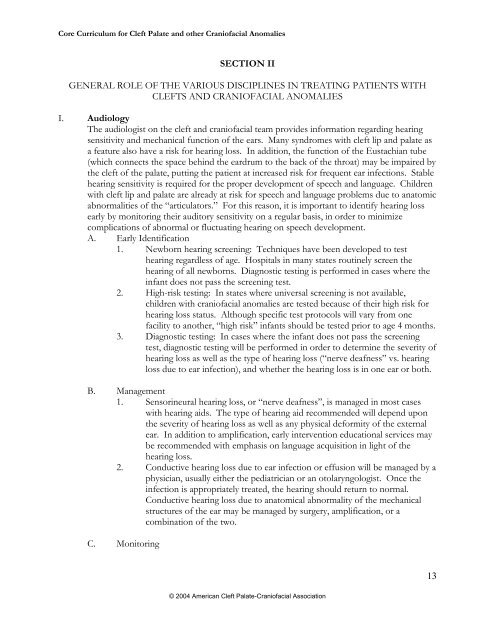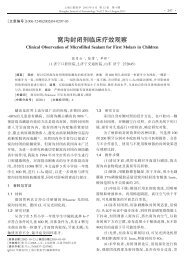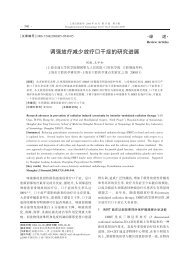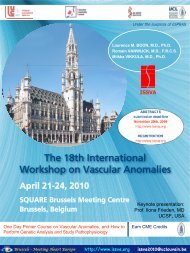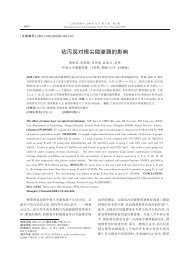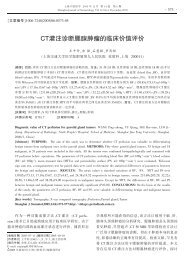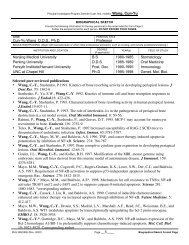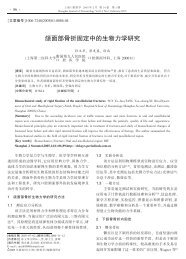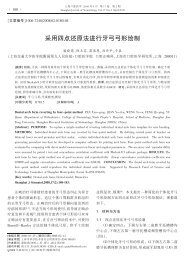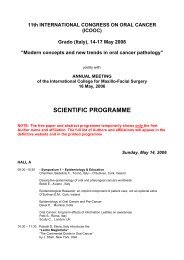core curriculum cleft lip/palate craniofacial anomalies
core curriculum cleft lip/palate craniofacial anomalies
core curriculum cleft lip/palate craniofacial anomalies
Create successful ePaper yourself
Turn your PDF publications into a flip-book with our unique Google optimized e-Paper software.
Core Curriculum for Cleft Palate and other Craniofacial Anomalies<br />
SECTION II<br />
GENERAL ROLE OF THE VARIOUS DISCIPLINES IN TREATING PATIENTS WITH<br />
CLEFTS AND CRANIOFACIAL ANOMALIES<br />
I. Audiology<br />
The audiologist on the <strong>cleft</strong> and <strong>craniofacial</strong> team provides information regarding hearing<br />
sensitivity and mechanical function of the ears. Many syndromes with <strong>cleft</strong> <strong>lip</strong> and <strong>palate</strong> as<br />
a feature also have a risk for hearing loss. In addition, the function of the Eustachian tube<br />
(which connects the space behind the eardrum to the back of the throat) may be impaired by<br />
the <strong>cleft</strong> of the <strong>palate</strong>, putting the patient at increased risk for frequent ear infections. Stable<br />
hearing sensitivity is required for the proper development of speech and language. Children<br />
with <strong>cleft</strong> <strong>lip</strong> and <strong>palate</strong> are already at risk for speech and language problems due to anatomic<br />
abnormalities of the “articulators.” For this reason, it is important to identify hearing loss<br />
early by monitoring their auditory sensitivity on a regular basis, in order to minimize<br />
complications of abnormal or fluctuating hearing on speech development.<br />
A. Early Identification<br />
1. Newborn hearing screening: Techniques have been developed to test<br />
hearing regardless of age. Hospitals in many states routinely screen the<br />
hearing of all newborns. Diagnostic testing is performed in cases where the<br />
infant does not pass the screening test.<br />
2. High-risk testing: In states where universal screening is not available,<br />
children with <strong>craniofacial</strong> <strong>anomalies</strong> are tested because of their high risk for<br />
hearing loss status. Although specific test protocols will vary from one<br />
facility to another, “high risk” infants should be tested prior to age 4 months.<br />
3. Diagnostic testing: In cases where the infant does not pass the screening<br />
test, diagnostic testing will be performed in order to determine the severity of<br />
hearing loss as well as the type of hearing loss (“nerve deafness” vs. hearing<br />
loss due to ear infection), and whether the hearing loss is in one ear or both.<br />
B. Management<br />
1. Sensorineural hearing loss, or “nerve deafness”, is managed in most cases<br />
with hearing aids. The type of hearing aid recommended will depend upon<br />
the severity of hearing loss as well as any physical deformity of the external<br />
ear. In addition to amplification, early intervention educational services may<br />
be recommended with emphasis on language acquisition in light of the<br />
hearing loss.<br />
2. Conductive hearing loss due to ear infection or effusion will be managed by a<br />
physician, usually either the pediatrician or an otolaryngologist. Once the<br />
infection is appropriately treated, the hearing should return to normal.<br />
Conductive hearing loss due to anatomical abnormality of the mechanical<br />
structures of the ear may be managed by surgery, amplification, or a<br />
combination of the two.<br />
C. Monitoring<br />
13<br />
© 2004 American Cleft Palate-Craniofacial Association


